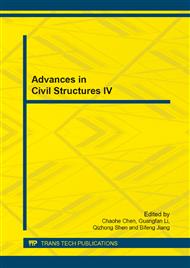p.648
p.653
p.659
p.663
p.667
p.671
p.675
p.679
p.687
Contrastive Research on the Influence of Eccentricity for Autoclaved Fly Ash Solid and Perforated Brick Masonry
Abstract:
For studying the influence of eccentricity e on autoclaved fly ash solid and perforated brick masonry. Adopted method is that eccentric compression tests were conducted on 24 autoclaved fly ash solid brick masonry samples and 24 autoclaved fly ash perforated brick masonry samples. The damage patterns and test results are comparative analyzed. The experimental results indicate that the strain distribution in section accord with plane section assumption and the eccentric compressive capacity decreases proportionally as e increases. In conclusion, The limit value of eccentricity e are given.
Info:
Periodical:
Pages:
667-670
Citation:
Online since:
July 2014
Authors:
Price:
Сopyright:
© 2014 Trans Tech Publications Ltd. All Rights Reserved
Share:
Citation:


